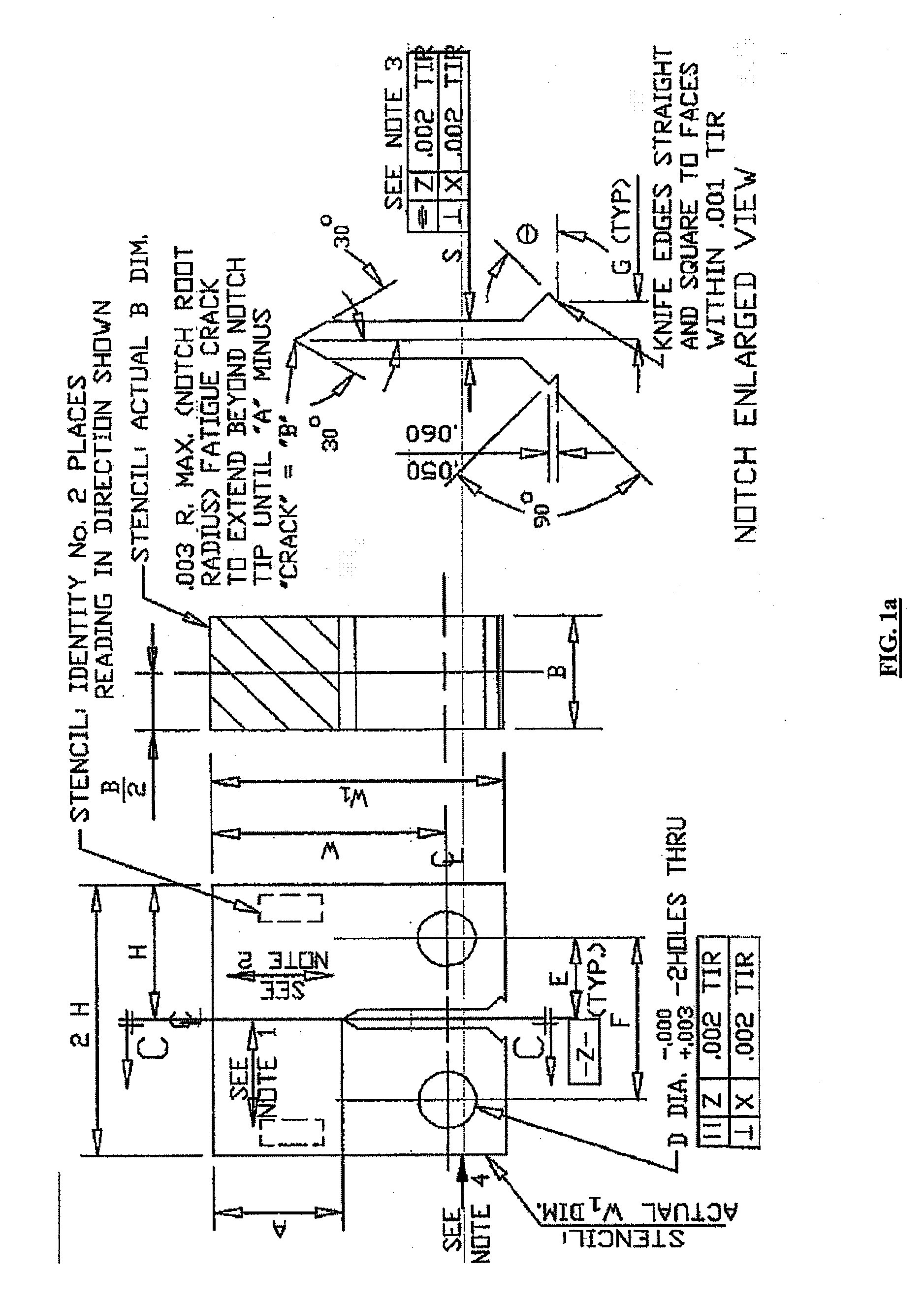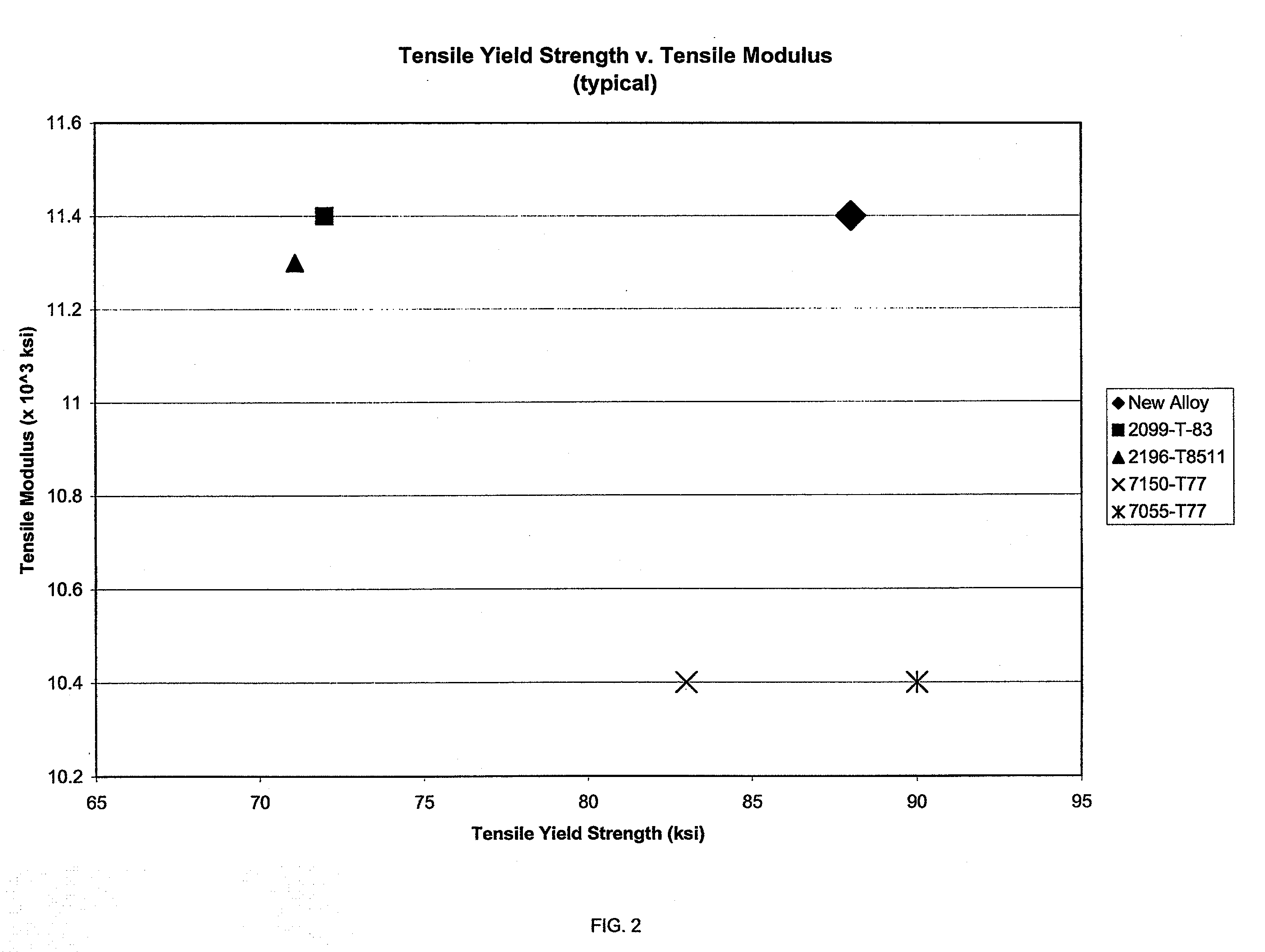Aluminum-copper-lithium alloys
a technology of copper-lithium alloys and alloys, applied in the field of copper-lithium alloys, can solve the problems of high difficulty in maintaining dimensional tolerances, -sectional measurements and attribute tolerances, and generally inability to compressively work with extruded products, and achieve the effect of improving the combination of properties
- Summary
- Abstract
- Description
- Claims
- Application Information
AI Technical Summary
Benefits of technology
Problems solved by technology
Method used
Image
Examples
example 1
[0056]Two ingots, 23″ diameter×125″ long, are cast. The approximate composition of the ingots is provided in Table 4, below (all values in weight percent). The density of the alloy is 0.097 lb / in3.
TABLE 4Composition of Cast AlloyCuLiZnAgMgMnBalance3.92%1.18%0.52%0.48%0.34%0.34%aluminum,grain structurecontrolelements,incidentalelements andimpurities
[0057]The two ingots are stress relieved, cropped to 105″ lengths each and ultrasonically inspected. The billets are homogenized as follows:[0058]18 hour ramp to 930° F.;[0059]8 hour hold at 930° F.;[0060]16 hour ramp to 946° F.;[0061]48 hour hold at 946° F.
[0062](furnace requirements of −5° F., +110° F.)
[0063]The billets are then cut to the following lengths:[0064]43″—qty of 1[0065]31″—qty of 1[0066]30″—qty of 1[0067]44″—qty of 1
[0068]Final billet preparation (pealed to the desired diameter) for extrusion trials are completed. The extrusion trial process involves evaluation of 4 large press shapes and 3 small press shapes.
[0069]Three of t...
example 2
[0078]Ten 23″ diameter ingots are cast. The approximate composition of the ingots is provided in Table 6, below (all values are weight percent). The density of the alloy is 0.097 lb / in3.
TABLE 6Composition of Cast AlloyCastCuLiZnAgMgMnBalance1-A3.95%1.18%0.53%0.50%0.36%0.26%aluminum, grain1-B3.81%1.15%0.49%0.49%0.34%0.28%structure controlelements, incidentalelements andimpurities
[0079]The ingots are stress relieved and three ingots of cast 1-A and three ingots of cast 1-B are homogenized as follows:[0080]Furnace set at 940° F. and charge all 6 ingots into said furnace;[0081]8 hour soak at 925-940° F.;[0082]Following 8 hour hold, reset the furnace to 948° F.;[0083]After 4 hours, reset the furnace to 955° F.;[0084]24 hour hold 940-955° F.
[0085]The billets are cut to length and pealed to the desired diameter. The billets are extruded into 7 large press shapes. The shape thicknesses range from 0.75 inch to 7 inches thick. Extrusion speeds and press thermal settings are in the range of 3-...
PUM
| Property | Measurement | Unit |
|---|---|---|
| Fraction | aaaaa | aaaaa |
| Mass | aaaaa | aaaaa |
| Density | aaaaa | aaaaa |
Abstract
Description
Claims
Application Information
 Login to View More
Login to View More - R&D
- Intellectual Property
- Life Sciences
- Materials
- Tech Scout
- Unparalleled Data Quality
- Higher Quality Content
- 60% Fewer Hallucinations
Browse by: Latest US Patents, China's latest patents, Technical Efficacy Thesaurus, Application Domain, Technology Topic, Popular Technical Reports.
© 2025 PatSnap. All rights reserved.Legal|Privacy policy|Modern Slavery Act Transparency Statement|Sitemap|About US| Contact US: help@patsnap.com



